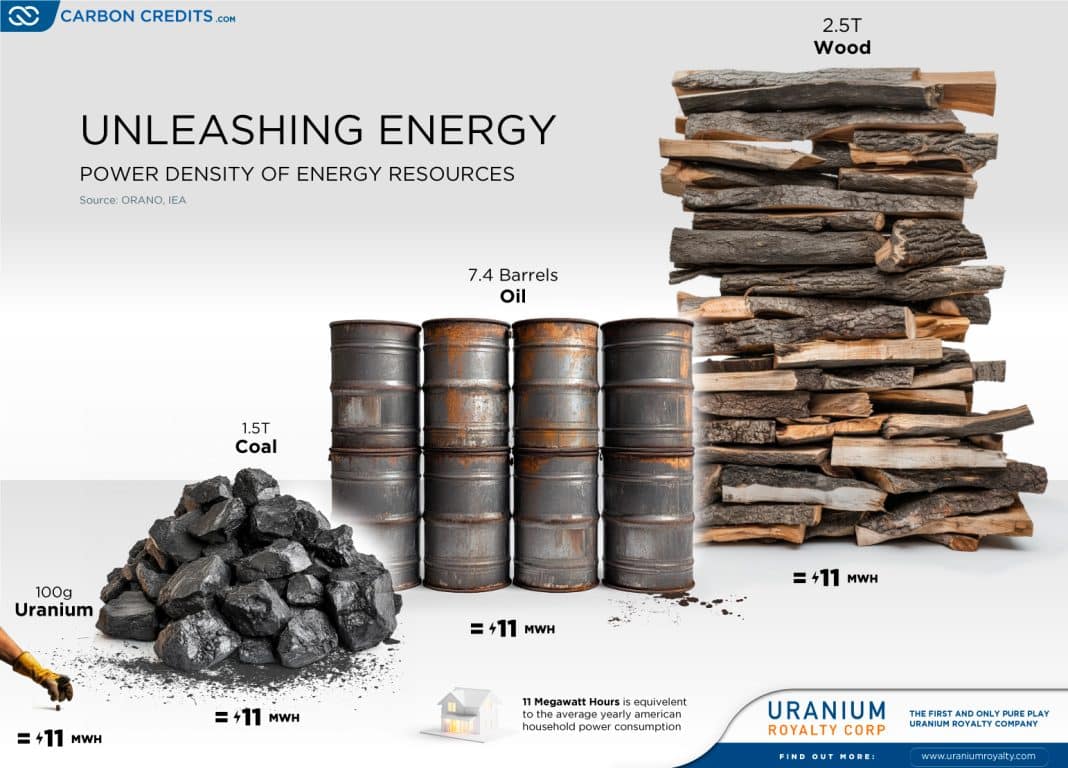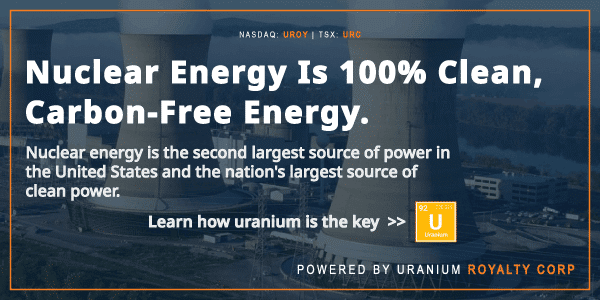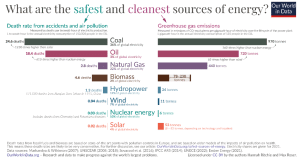Disseminated on behalf of Uranium Royalty Corp.
Power density is essential for evaluating how efficiently a system works. It is a measurement of the power it can handle or produce compared to its size or volume.
The infographic compares the power density of different energy sources—wood, oil, coal, and uranium—based on how much energy each can generate in megawatt hours (MWh). The comparison uses a baseline of 11 MWh, which is the average annual electricity consumption of an American household.
As you can see, nuclear energy is by far more efficient. This is because just a small amount of uranium can generate as much power as large quantities of fossil fuels or wood. Here’s the breakdown:
- Wood: You need about 2.5 tons of wood to generate 11 MWh of electricity. This hefty amount shows how low wood’s energy density is compared to other fuel sources.
- Oil: It takes 7.4 barrels of oil to produce the same 11 MWh. While oil is more energy-dense than wood, it still requires a significant amount to reach this energy target.
- Coal: Producing 11 MWh takes about 1.5 tons of coal. This makes coal more efficient than wood and oil in terms of energy density.
- Uranium: Amazingly, just 100 grams of uranium can generate 11 MWh. This emphasizes the incredible energy density of nuclear fuel compared to traditional fossil fuels or biomass.
 The Heavyweight Champ of Low Emissions
The Heavyweight Champ of Low Emissions
The infographic clearly shows that uranium has a much higher energy density than traditional energy sources. While renewables and biomass are important for combating carbon emissions, nuclear energy is much more efficient. It can meet large-scale energy demands with very little fuel.
Right now, nuclear power provides 10% of the world’s electricity.
According to the US Energy Information Administration (EIA), nuclear power is projected to increase by 22% between 2022 and 2050.
However, as overall electricity generation grows, nuclear’s share is set to decline, dropping from around 10% of global electricity generation to about 8% by 2050.
With its high power density, nuclear energy is crucial for reducing emissions and meeting global energy needs in this era of clean energy transition.
Notably, energy-related emissions make up about 80% of all human-related greenhouse gas emissions in the U.S. and EU. Despite electricity accounting for only 20% of total energy consumption, it generates over 40% of energy-related emissions.
Burning fossil fuels like coal, oil, and gas releases around 34 billion tonnes of CO2 annually, with coal contributing 45%, oil 35%, and gas 20%. In contrast, nuclear power produces significantly lower carbon emissions.
- According to the UN IPCC, nuclear energy emits about 12 grams of CO2 equivalent per kWh. This is closely the same as wind and much lower than solar, making it a cleaner electricity source.
Talking about environmental impact, nuclear energy is superior and a cleaner resource.
It can significantly lower emissions by using less material making it a better sustainable alternative to fossil fuels and biomass.
Learn More >> The Atomic Awakening: Unplugging The Energy Crisis | Fueled by Uranium
Carboncredits.com receives compensation for this publication and has a business relationship with any company whose stock(s) is/are mentioned in this article.
Additional disclosure: This communication serves the sole purpose of adding value to the research process and is for information only. Please do your own due diligence. Every investment in securities mentioned in publications of carboncredits.com involves risks that could lead to a total loss of the invested capital.




